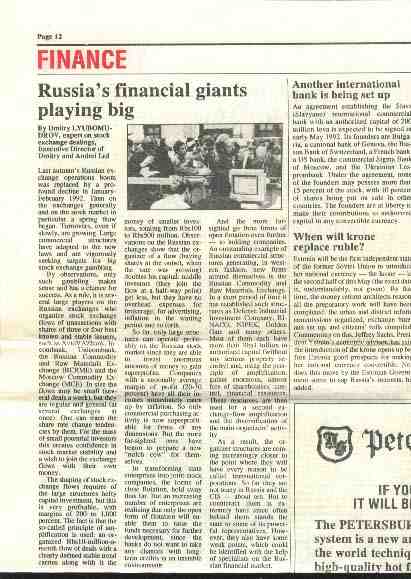![]()
Publications. Financial Articles : # 10
| Russia's financial giants playing big | |
 |
Article in the Newspaper
"Financial & Business News", # 19, May 1992, page 12 Author - Dmitry
Lyubomudrov |
![]()
By Dmitry LYUBOMUDROV, expert on stock exchange dealings,
Executive Director of Dmitry and Andrei Ltd
Last autumn's Russian exchange operations boom was replaced by a profound decline in
January-February 1992. Then on the exchanges generally and on the stock market in
particular a spring thaw began. Turnovers, even if slowly, are growing. Large commercial
structures have adapted to the new laws and are vigorously seeking targets for big stock
exchange gambling.
By observations, only such gambling makes sense and has a chance for success. As a rule,
it is several large players on the Russian exchanges who organize stock exchange flows of
transactions with shares of three or four best known and stable issuers, such as
AvtoVAZbank, Incombank, Unicombank, the Russian Commodity and Raw Mater'als Exchange
(RCRME) and the Moscow' Commodity Exchange (MCE). In size the flows may be small (several
deals a week), but they are regular and general (at several exchanges at once). One can
trace the share rate change tendencies by them. For the mass of small potential investors
this creates confidence in stock market stability and a wish to join the exchange flows
with their own money.
The shaping of stock exchange flows requires of the large structures hefty capital
investment, but this is very profitable, with margins of 200 to 1,000 percent. The fact is
that the so-called principle of amplification is used: an organized Rbs 10-million-a-month
flow of deals with a clearly defined stable trend carries along with it the money of
smaller investors, totaling from Rbs 100 to Rbs 500 million. Observations on the Russian
exchanges show that the organizer of a flow (buying shares at the outset, when the rate
was growing) doubles his capital: middle investors (they join the flow at a half-way
point) get less, but they have no overhead expenses for brokerage, for advertising,
inflation in the waiting period and so forth.
So far, only large structures can operate profitably on the Russian stock market since
they are able to invest enormous amounts of money to gain superprofits. Companies with a
nationally average margin of profit (20-30 percent) have all their incomes immediately
eaten up by inflation. So only commercial purchasing activity is now superprofitable for
firms of any dimensions. But the more far-sighted ones have begun to prepare a new
"milch cow" for themselves.
In transforming state enterprises into joint-stock companies, the forms of close
flotation, hold sway thus far. But an increasing number of enterprises are realizing that
only the open form of flotation will enable them to raise the funds necessary for further
development, since the banks do not want to take any chances with long-term credits in an
unstable environment
And the more far-sighted go from forms of open flotation even further — to holding
companies. An outstanding example of Russian commercial structures generating, in western
fashion, new firms around themselves is the Russian Commodity and Raw Materials Exchange.
In a short period of time it has established such structures as Defense Industrial
Investment Company, RINACO, NIPEK, Golden Gate and many others. Most of them each have
more than Rbs 1 billion in authorized capital (without any serious property security) and,
using the principle of amplification, gather enormous, almost free of shareholders'
control, financial resources. These resources are then used for a second exchange-flow
amplification and the diversification of the main organizers' activity.
As a result, the organizer structures are coming increasingly closer to the point where
they will have every reason to be called transnational corporations. So far they are not
many in Russia and the CIS - about ten. But to counteract them is extremely hard since
often behind them stands the state or some of its powerful representatives. However, they
also have some weak points, which coulc be identified with the help of specialists on the
Russian financial market.